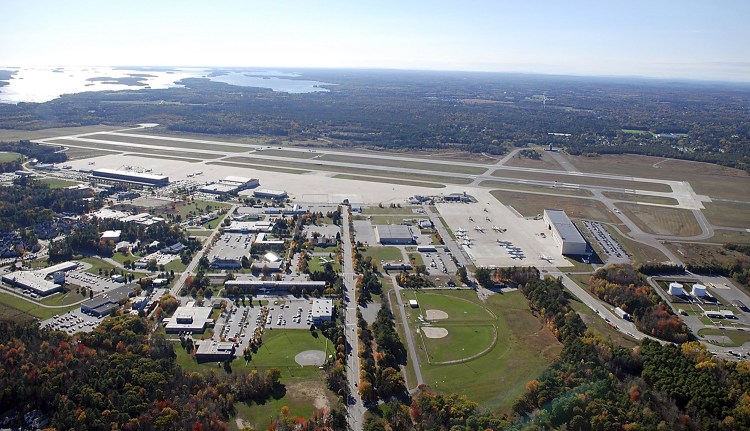BRUNSWICK — Navy officials Thursday touted test results showing little to no contamination in private wells near the former Brunswick Naval Air Station but pledged to continue sampling for a potentially harmful chemical once used in aviation firefighting.
“Probably the most important point is nobody here has been negatively impacted: We did all of the residential well sampling and they came back clean,” said Paul Burgio, the Navy’s environmental coordinator for the Brunswick base. “Nobody is drinking contaminated water … so this is a really good story. We still have information that we are going to collect and gather.”
The Navy has been testing for the presence of perfluorinated compounds in groundwater, surface water and sediments. Once widely used in both industrial and household products, so-called PFCs have been shown to cause health problems in laboratory animals – including impacts to reproduction and development – and are listed as an “emerging contaminant” by the U.S. Environmental Protection Agency.
On Thursday, members of the Restoration Advisory Board that helps oversee environmental cleanup at the former air station received updates on testing for PFCs both on-base and off-base.
Tests conducted last year on more than 30 private wells just outside the base showed little to no PFCs in the water, suggesting plumes of the chemicals are not migrating outside of known contamination hotspots on base.
Nineteen of 29 private wells in a neighborhood along Coombs Road tested positive for one type of PFC – also often referred to by the acronym as PFAS – but at levels far short of the EPA’s “health advisory” threshold. Another type of PFC was detected in eight of the wells but, again, well below the 70 parts per trillion health advisory level for drinking water.
Samples collected from four wells north of the base also either had no detectable PFCs or levels below the EPA threshold. While several surface water sources – stormwater or drainage sites – had levels higher than the EPA’s health advisory, the levels “do not pose a human health risk/hazard above target levels,” according to a draft report.
Burgio said the Navy would conduct further testing of a subset of those wells in the future, with landowner permission, to ensure conditions have not changed.
“Don’t lose sight of the fact that the closest residential wells have all come back clean and the Navy continues to investigate PFAS both on- and off-base and in public water,” Burgio said.
All homes and businesses located on the former base are connected to municipal water supplies and are, therefore, not considered to be at risk from PFC contamination in drinking water.
Brunswick Area Citizens for a Safe Environment, a group that closely monitors base cleanup efforts, had been pushing for tests of private wells near the base. Member Carol White said the group was pleased the Navy agreed to the sampling.
“I feel a lot better about the PFC problem around the residential levels,” White said. “I, personally, still have concerns on the northern part just because of the limited number of sites.”
Perfluorinated compounds are a class of chemicals that were widely used in airport firefighting foam because of their ability to essentially form a blanket over flammable petroleum products. But PFCs were also used in countless household products, including Teflon cookware, stain-resistant carpet and fast-food wrappers.
The Navy has known for years about PFC contamination at several sites on the former air station, which closed in 2011 and now serves as the Brunswick Landing business campus.
Recent tests around the site of a former building that stored the firefighting foam, known as Building 653, found elevated PFC levels in groundwater. While those levels were above safe levels for drinking water, they were below the level that would pose a human health risk for incidental exposure, according to contractors who performed the testing for the Navy.
The Navy and contractor plan further tests and are still evaluating options for addressing the contamination.
Other sites on the base have shown even higher levels, based on previous testing. The Navy plans to launch another round of basewide testing starting this month and continuing into next year, including sampling 40 groundwater sites, seven stormwater systems and five surface water sites.
PFCs have made headlines in communities near military bases across the country, even forcing some communities to turn off public water supplies found to be contaminated with the chemicals. Some adults and children living or working near the former Pease Air Force Base in Portsmouth, N.H., for example, have substantially elevated PFC levels in their blood.
But Burgio pointed out that the Navy began testing on-base groundwater for PFCs years ago and continues to expand that monitoring program.
“If you look across the country, a lot of it is piecemeal or disorganized,” Burgio said. “We, I think, have had a very comprehensive and inclusive process.”
White and other members of the Brunswick Area Citizens for a Safe Environment also credited the Navy for working with them on the issue.
Kevin Miller can be contacted at:
kmiller@pressherald.com
Send questions/comments to the editors.




Success. Please wait for the page to reload. If the page does not reload within 5 seconds, please refresh the page.
Enter your email and password to access comments.
Hi, to comment on stories you must . This profile is in addition to your subscription and website login.
Already have a commenting profile? .
Invalid username/password.
Please check your email to confirm and complete your registration.
Only subscribers are eligible to post comments. Please subscribe or login first for digital access. Here’s why.
Use the form below to reset your password. When you've submitted your account email, we will send an email with a reset code.